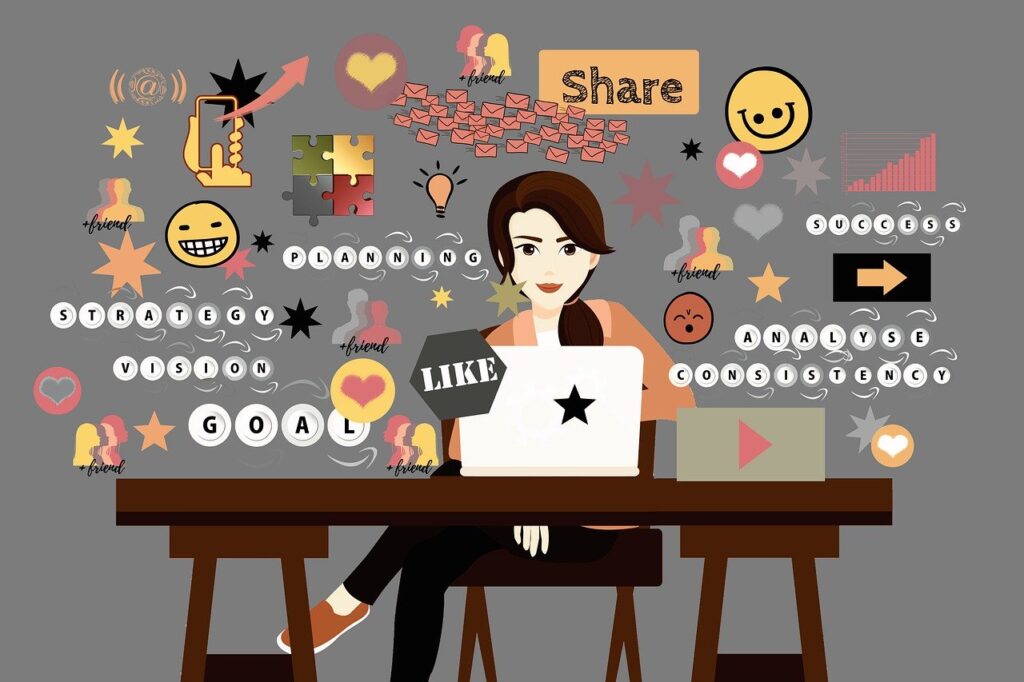
Have you ever scrolled through a social media feed filled with oddly realistic portraits that look like paintings but seem computer-generated? Or perhaps you’ve encountered a catchy marketing jingle that appears out of nowhere?
Believe it or not, these could be creations of generative AI, a powerful branch of Artificial Intelligence (AI) rapidly changing how we create content.
Unlike traditional AI which analyzes data and makes predictions, generative AI takes things one step further. It can create new content, from captivating images and musical pieces to engaging text formats like articles and scripts.
This beginner-friendly guide will break down the core concepts of generative AI, explore how it works, and delve into the exciting applications transforming various industries. So, buckle up and get ready to unlock the potential of this revolutionary technology!
What is Generative AI?
Imagine a computer program that can understand information and use that knowledge to create entirely new things. That’s the magic of generative AI, a subfield of Artificial Intelligence (AI) revolutionizing how we interact with technology.
Generative AI is a version of artificial intelligence (AI) that can create entirely new data, like text, images, or music. It learns from massive datasets and uses that knowledge to generate fresh, original content. This technology is changing industries like content creation, art and design, and scientific research.
Unlike traditional AI, which excels at analyzing data and making predictions, generative AI takes the creative leap of producing original content.
Here’s what sets generative AI apart from traditional AI:
- Traditional AI excels at analyzing existing information and making predictions. For example, a recommendation system on an e-commerce platform analyzes your past purchases to suggest similar items you might like.
- Generative AI, on the other hand, is all about forging new ground. It can generate never-before-seen content, pushing the boundaries of creative expression and innovation.
Traditional AI is like a master analyst, sifting through mountains of information to identify trends and patterns. Generative AI, on the other hand, is like a visionary artist, inspired by what it learns to craft something entirely new – a captivating image, a catchy melody, or even a thought-provoking news article.
How Does Generative AI Work?
Generative AI models are trained on massive datasets of text, images, audio, or other data formats. During training, these models learn to identify patterns and relationships within the data.
Once trained, generative AI models can create entirely new content based on the patterns they’ve learned. For text generation, the model predicts the most likely next word or sequence of words based on the input. For image generation, the AI converts text prompts into visual representations.
The key innovation behind modern generative AI is using deep learning neural networks, which allow these models to understand and generate complex data like natural language and photorealistic images. There are different types of Generative AI and they include transformers for text and diffusion models or generative adversarial networks (GANs) for images.
While the technical details are complex, the core concept is using vast amounts of training data to “learn” how to generate new, original content that resembles the data it was exposed to during training. This unlocks boundless creative and productive possibilities.
.
Exploring the Applications of Generative AI
The true power of generative AI lies in its remarkable versatility. It’s no longer a figment of science fiction; generative AI applications are making waves across many industries and transforming how we create, discover, and innovate.
Content Creation Unleashed
Imagine a world where writer’s block becomes a thing of the past. Generative AI is revolutionizing content creation by assisting with various text formats. Need a catchy social media post or a compelling marketing email?
AI can generate creative ideas that spark engagement. Are you stuck on that blog article introduction? Generative models can provide drafts or outlines to get your creative juices flowing.
Even scriptwriting can benefit from AI’s ability to suggest dialogue variations or plot points, allowing writers to focus on refining the narrative.
Art and Design: A New Artistic Muse
The world of art and design is no stranger to generative AI’s influence. Artists can leverage these models to explore new artistic styles, generate variations on existing designs, or even create entirely new pieces.
Imagine an AI tool that can paint a portrait in the style of Van Gogh or design a futuristic cityscape based on user prompts. This technology empowers artists to experiment and push creative boundaries, fostering the birth of unique and innovative art forms.
You can have any image you desire by simply typing a few lines of text, known as a text prompt. That’s the power of AI Image Generation.
Accelerating Scientific Discovery
Beyond the creative realm, generative AI is making significant strides in scientific research. In drug discovery and materials science, researchers can utilize generative models to simulate new molecules with specific properties. This allows for faster exploration of potential drug candidates or the creation of novel materials with desired functionalities.
Generative AI essentially acts as a powerful tool for scientific exploration, accelerating research and development processes that were previously time-consuming and resource-intensive.
Beyond Creativity and Science
The applications of generative AI extend far beyond art, design, and scientific research. Here are a few additional ways this technology is transforming various industries:
- Personalization: Generative AI can personalize user experiences across different platforms. For example, e-commerce platforms can use AI to recommend products tailored to individual customer preferences, while streaming services can curate personalized playlists based on listening habits.
- Accessibility Tools: Generative AI can be a powerful tool for creating accessibility features. AI-generated text descriptions of images can aid visually impaired users, while speech-to-text conversion powered by generative models can assist people with hearing difficulties.
- Fake News Detection: Generative AI is being explored for its potential to identify and flag fake news articles or deepfakes (manipulated videos). By analyzing language patterns and identifying inconsistencies, AI models can help combat the spread of misinformation online.
These are just a few examples of how generative AI is making its mark on the world. As technology evolves, we expect even more innovative applications to emerge, shaping the future across various sectors.
The Future of Generative AI
The future of generative AI is brimming with exciting possibilities. Advancements in this field are happening rapidly, constantly unlocking new applications that will fundamentally change how we interact with technology.
Personalization on Steroids: Imagine a world where your online experience is not tailored, but truly anticipates your needs. Generative AI can potentially personalize user experiences across platforms in ways we haven’t even imagined yet.
Think about educational tools that adapt to your learning style or virtual assistants that can predict your needs before you ask.
A More Inclusive World: Generative AI can be a powerful force for inclusivity. AI-generated content creation tools can break down accessibility barriers, allowing people with disabilities to engage with information and express themselves more easily.
Text-to-speech powered by generative models can assist people with visual impairments, while AI-generated captions for videos can enhance accessibility for the deaf and hard-of-hearing community.
However, with great power comes great responsibility. As generative AI continues to evolve, ethical considerations need to be addressed. Issues like potential bias in AI models and the misuse of deepfakes for malicious purposes require careful attention.
Nevertheless, the potential benefits of generative AI far outweigh the challenges. By fostering responsible development and implementation, we can unlock the true potential of this technology to create a more personalized, inclusive, and innovative future for all.
Conclusion
Generative AI has emerged as a game-changer, pushing the boundaries of content creation across various fields. From crafting captivating poems to accelerating scientific discovery, this powerful technology is changing how we think, create, and innovate.
Remember, generative AI is still in its early stages, but the future holds immense potential. Whether you’re a curious learner or a professional looking to stay ahead of the curve, numerous resources are available to delve deeper. Online articles, tutorials, and even online courses can equip you with the knowledge to explore the exciting world of generative AI.
As we move forward, generative AI has the potential to revolutionize countless aspects of our lives. From personalized experiences to enhanced accessibility tools, this technology promises a more creative, inclusive, and innovative future. So, embrace the possibilities and get ready to witness the transformative power of generative AI unfold!


